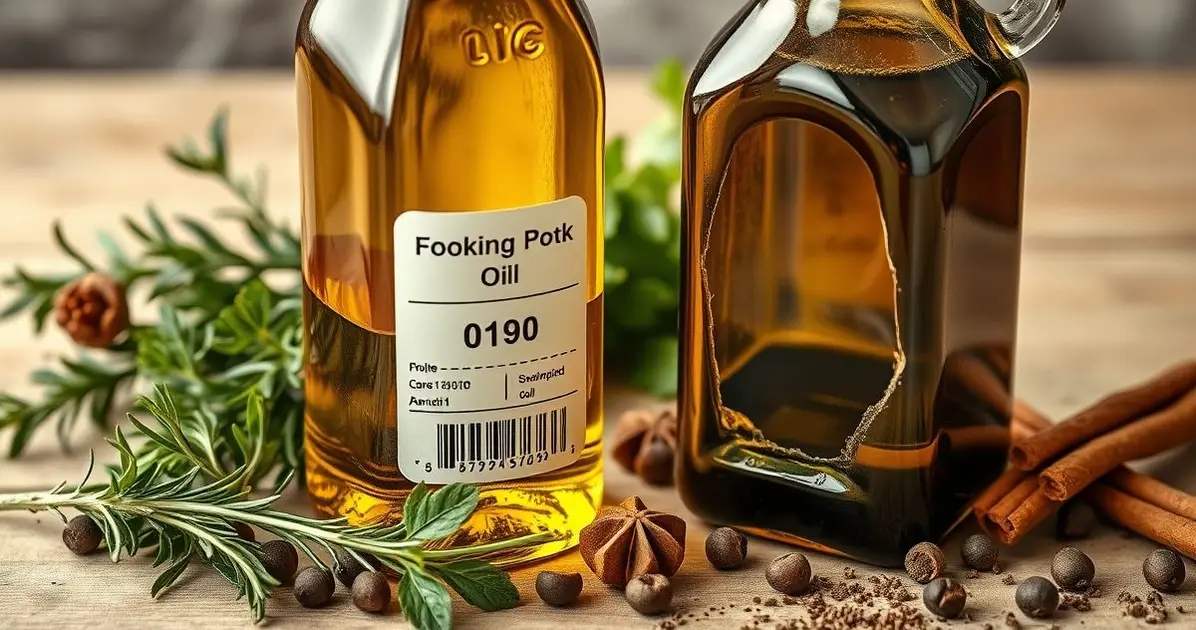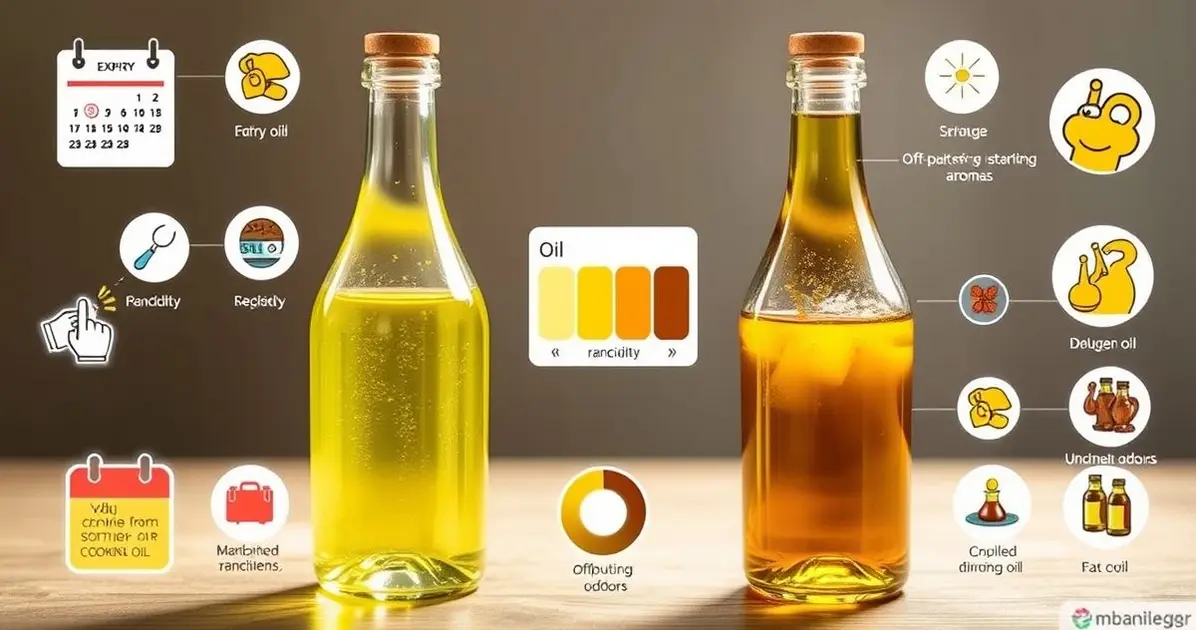Cooking oil does have a shelf life and can go bad over time. Factors like exposure to light, heat, and air can accelerate spoilage. Understanding the signs of bad oil can help maintain your culinary quality.
Can cooking oil go bad

Cooking oil can indeed go bad, typically through oxidation, leading to off-flavors and odors. To ensure freshness, store oil in a cool, dark place and check for visual or olfactory changes before use. Always note the expiration date on the label.
What Causes Cooking Oil to Go Bad?
Understanding what causes cooking oil to go bad is essential for anyone who enjoys cooking. The primary culprit behind oil spoilage is rancidity, which occurs when oils are exposed to three main factors: light, heat, and air.
1. Exposure to Light: Light, especially sunlight, can accelerate the oxidation process in oils. This exposure breaks down the fatty acids, leading to rancidity. That’s why it’s crucial to store your cooking oils in dark glass bottles or opaque containers to minimize light exposure.
2. Heat: High temperatures can also speed up the deterioration of cooking oils. Storing oils near the stove or in warm areas can lead to a shorter shelf life. Ideally, oils should be kept in a cool, dark place, such as a pantry or cupboard, away from heat sources.
3. Air Exposure: Oxygen in the air can react with the oil, causing oxidation. This reaction not only affects the flavor but also leads to the formation of harmful compounds. Always ensure that the cap is tightly sealed after each use to limit air exposure.
Additionally, the type of oil plays a significant role in its susceptibility to spoilage. Oils with higher levels of polyunsaturated fats, like flaxseed oil, are more prone to rancidity compared to oils rich in monounsaturated fats, like olive oil.
By understanding these causes, you can take proactive steps to extend the shelf life of your cooking oils and maintain their quality for delicious and safe cooking.
Shelf Life of Different Cooking Oils
The shelf life of cooking oils varies significantly depending on the type of oil and how it is stored. Here’s a breakdown of the shelf life for some common cooking oils:
1. Olive Oil: High-quality extra virgin olive oil typically lasts about 18-24 months when stored properly in a cool, dark place. Once opened, it’s best to use it within 6 months to a year for optimal flavor.
2. Canola Oil: Canola oil has a longer shelf life, usually around 2 years when unopened. After opening, it can remain good for about 1 year if kept in a cool, dark area.
3. Vegetable Oil: Similar to canola oil, vegetable oil can last up to 2 years unopened. Once opened, it should be used within 6-12 months for the best quality.
4. Peanut Oil: Peanut oil has a shelf life of about 1-2 years when stored properly. It’s known for its high smoke point, making it great for frying.
5. Coconut Oil: Unrefined coconut oil can last up to 2-3 years, while refined coconut oil has a shelf life of about 1-2 years. Its solid form at room temperature can help it last longer.
6. Sesame Oil: Unopened sesame oil can last for about 1-2 years, but once opened, it’s best to use it within 6 months to a year to maintain its flavor.
It’s important to note that these timeframes can vary based on storage conditions and oil quality. Always check for signs of spoilage, such as off smells or flavors, regardless of the expiration date. Proper storage and understanding the shelf life of your cooking oils can help you make the most of your culinary creations.

Signs of Spoilage in Cooking Oils
Recognizing the signs of spoilage in cooking oils is crucial for maintaining food safety and flavor in your dishes. Here are the key indicators that your cooking oil may have gone bad:
1. Rancid Smell: One of the most noticeable signs of spoilage is a rancid or off smell. Fresh cooking oil should have a neutral or pleasant aroma, while spoiled oil will emit a strong, unpleasant odor that can be quite distinct.
2. Unusual Flavor: If the oil tastes bitter, sour, or otherwise different from its normal flavor, it’s a sign that it has gone bad. Fresh oils should have a clean taste, while spoiled oils can impart off-flavors to your food.
3. Cloudiness: While some oils, like coconut oil, can appear cloudy when solidified, any unexpected cloudiness in liquid oils can indicate spoilage. If your oil is normally clear and suddenly looks murky or has sediment at the bottom, it’s best to discard it.
4. Changes in Color: A change in color can also signify spoilage. If the oil has darkened significantly or has developed a strange hue compared to when it was fresh, it may no longer be safe to use.
5. Foam or Bubbles: If you notice foam or bubbles forming in the oil, this could indicate that it has started to break down. Fresh oil should be smooth and free of any unusual texture.
6. Expiration Date: Always check the expiration date on the bottle. While some oils can last beyond their expiration date if stored properly, it’s a good rule of thumb to use oils before their listed date and to monitor them for any signs of spoilage.
By being aware of these signs, you can ensure that you are using fresh cooking oils, which will help enhance the quality and safety of your meals.
Best Practices for Storing Cooking Oils
Proper storage of cooking oils is essential to maintain their quality and extend their shelf life. Here are some best practices for storing your cooking oils:
1. Keep Oils in a Cool, Dark Place: Store cooking oils away from direct sunlight and heat sources. A pantry or cupboard is ideal, as it helps prevent the oils from becoming rancid due to heat and light exposure.
2. Use Dark Glass or Opaque Containers: If possible, choose oils that come in dark glass bottles or opaque containers. These types of packaging help block out light, which can accelerate spoilage.
3. Seal Tightly After Use: Always ensure that the cap or lid is tightly sealed after each use. This minimizes air exposure, which can lead to oxidation and rancidity.
4. Avoid Storing Near the Stove: While it may be convenient to keep oils near the cooking area, the heat from the stove can shorten their shelf life. Instead, store them in a cooler location.
5. Label and Date Your Oils: If you have multiple oils, consider labeling them with the date of purchase. This will help you keep track of their freshness and ensure you use the older oils first.
6. Refrigerate Certain Oils: Some oils, like flaxseed oil or nut oils, benefit from refrigeration to prolong their shelf life. Check the label for storage recommendations, as some oils may require refrigeration after opening.
By following these best practices, you can help ensure that your cooking oils remain fresh, flavorful, and safe to use in your culinary creations.
Conclusion
In conclusion, understanding the factors that contribute to cooking oil spoilage is vital for maintaining both the quality and safety of your culinary ingredients.
By recognizing the signs of spoilage—such as rancid smells, unusual flavors, and changes in appearance—you can make informed decisions about when to discard oil.
Additionally, knowing the shelf life of different cooking oils and implementing best storage practices can significantly extend their usability.
Keeping oils in a cool, dark place, using appropriate containers, and sealing them tightly after each use are simple yet effective strategies.
Ultimately, by being proactive about the storage and care of your cooking oils, you can enjoy delicious meals and ensure that your cooking remains both safe and flavorful.
So, take these tips to heart and keep your oils in top condition for all your culinary adventures!
FAQ – Frequently Asked Questions about Cooking Oil Spoilage
Can cooking oil go bad?
Yes, cooking oil can go bad due to rancidity caused by exposure to light, heat, and air.
What are the signs that cooking oil has spoiled?
Signs of spoilage include a rancid smell, unusual flavor, cloudiness, changes in color, foam or bubbles, and an expired date.
How long can different cooking oils last?
Shelf life varies: olive oil lasts 18-24 months, canola oil up to 2 years, and coconut oil can last 2-3 years.
What is the best way to store cooking oils?
Store cooking oils in a cool, dark place, preferably in dark glass or opaque containers, and seal them tightly after each use.
Should I refrigerate any cooking oils?
Yes, some oils like flaxseed oil or nut oils benefit from refrigeration to prolong their shelf life.
How can I tell if my cooking oil is still good to use?
Check for signs of spoilage such as rancid odor, off-flavors, cloudiness, and always refer to the expiration date.
See more
Discover plenty of easy and delicious recipes you can make at home, from hearty dinners to indulgent desserts and wholesome breakfasts.




